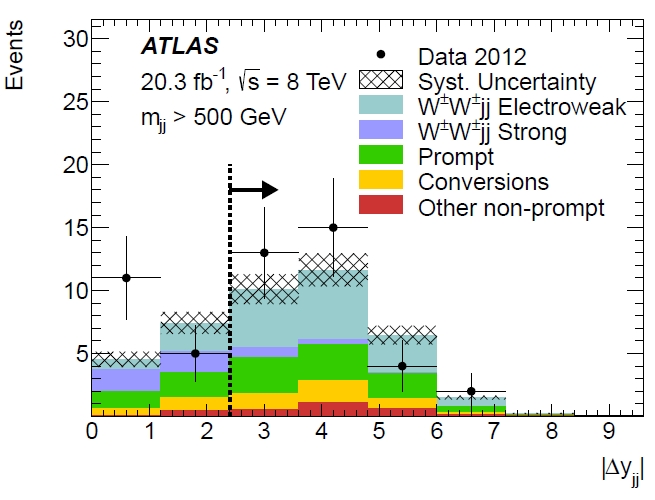You realize that such is a quite extraordinary concept. You should picture two cars launched one against the other at high speed, when the drivers just a moment before the impact shoot a bullet at each other. As a result of the recoils, the two cars deviate from their straight path and miss each other, while it is the bullets that collide with one another.
W bosons are seldom fired by energetic protons, as the interaction responsible of their emission by a matter particle (be it a quark or a lepton -in this case a quark, which is a proton constituent) is much weaker than the strong interaction which usually takes place when two protons collide. Hence you can understand that we are talking of a really rare occurrence: this makes sense, as the Higgs discovery was really a tough experimental challenge.
If rather than looking for Higgs production by vector-boson scattering we try to isolate W boson pairs that, although emitted by the same mechanism, "missed" each other -as if we looked for pairs of bullets emitted by the two colliding - we will have trouble separating such events from ones where the two W bosons were emitted by a more normal quark-antiquark interaction when the protons collided: such mixed "strong and weak" interactions are much more frequent and it becomes very hard to identify the strange vector boson scatterings we are after. However, we can look for pairs of W boson of the same electric charge: in this case, strong interactions are suppressed, and the signal can be evidenced more readily.
That is precisely what ATLAS just did, as reported in a paper sent to the Arxiv a week ago. They looked for the signal of two W bosons, each producing a electron-neutrino or muon-neutrino pair, with the two charged leptons being of the same charge. The event topology is further enriched in the signal component by selecting events that also possess two energetic jets, as the W boson emissions produce a recoil of the quarks that fired them. These quarks are thus expelled from the parent proton and produce hadronic jets. By selecting pairs of jets that have a large invariant mass the vector boson scattering signal is amplified.
At the end of the selection chain, ATLAS produces a "money plot" where a kinematical characteristic of the event candidates (a function of the angle between the two jets) is compared between data (black points with error bars) and the sum of all expected standard model processes (stacked coloured histograms), which of course includes the searched signal (in light blue). As you can see, the "signal region" at high values of the kinematical variable shown in the graph would contain an excess of data with respect to backgrounds, if one were to assume that no vector-boson scattering contribution were present.

The excess of signal-like events allows ATLAS to estimate the cross section of this fancy process, which is found in good agreement with predictions (as the graph itself does show). The cross section of electroweak production of same-sign W pairs, multiplied by acceptance and selection factors, is found to be 1.3+-0.4+-0.2 femtobarns.
What is next ? It would be really nice to see pairs of Z bosons produced by the same mechanism, but the lack of a charge makes the separation of that process from "ordinary" production of Z bosons really hard at present. Rather, it will be interesting to revisit the studied process with more statistics and higher center-of-mass energy next year, as the variable shown in the graph above, which is a characteristic "tag" of the vector boson scattering, is not very well studied and would benefit from a higher statistical power.




Comments